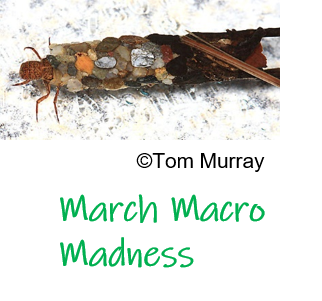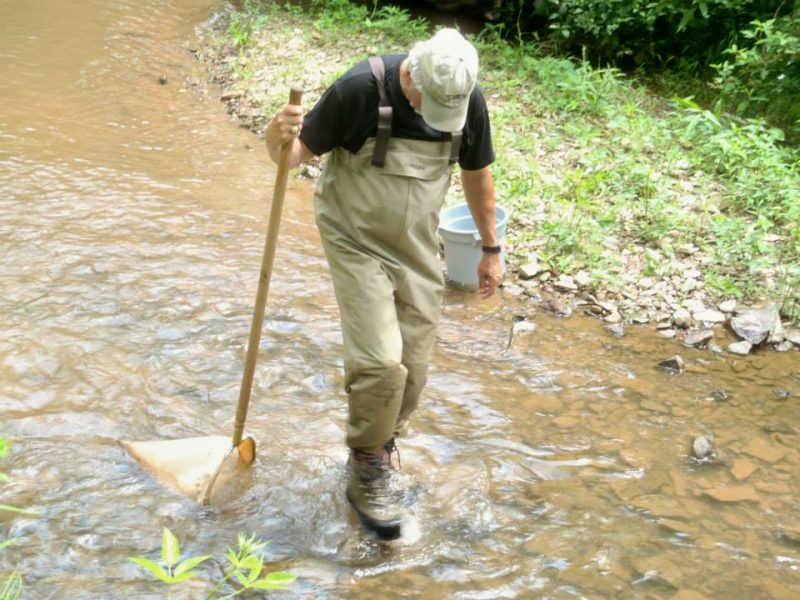The NCAA College basketball tournament is underway and Macro Madness continues at NPC. We’ve been highlighting different macroinvertebrates on our Facebook page this month, but have really explained how biologists look for macroinvertebrates or collect them.
Biologists use several methods to collect macroinvertebrates. The one we’re going to describe is the D-frame kicknet method because that’s what we have photos of.
Biologists shuffle their feet in the stream for a specified length of time over a specified distance. A D-shaped net is used to scoop up the materials dislodged by the shuffling and kicking feet.
The material in the net is transferred to a container, treated with ethanol to preserve it and taken back to the lab for processing. A random sample will be sorted with all the macroinvertebrates (water insects) grouped by taxa.
Looking at the sorted sample, an aquatic biologist will consider what taxa are present, those that are tolerant of polluted water, or those that are intolerant of pollution and need clean water? How many taxa are present? How many individuals are in each of the taxa? Comparing the answers to these questions and other will provide a better understanding of how the in-stream restoration work is improving water quality.
Dragonfly Nymphs (Gomphus)
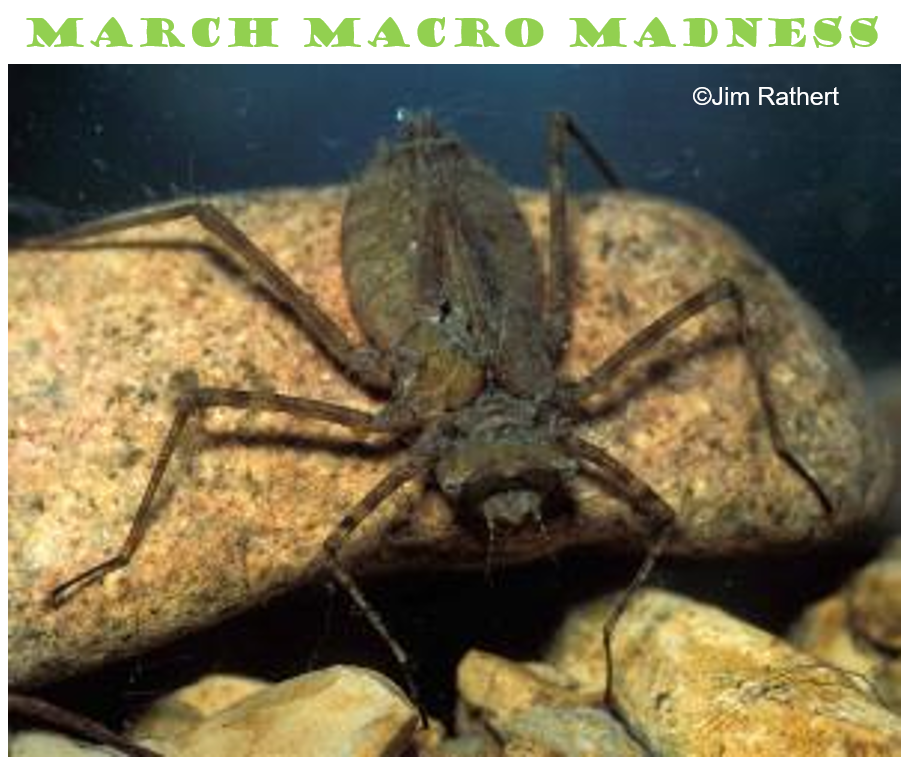
The life stages of a dragonfly are egg to larvae to adult. The dragonfly larvae are also called nymphs.
Dragonfly nymphs live in the streams and creeks and rivers. They need water that is pretty clean.
They are usually a drab color. They have 6 legs, large eyes, and small wing buds on their back.
They breathe through gills kind of like a fish. A dragonfly nymph’s gills are located inside the rectum. They drawing water in and out of their hind end, over the gills, to breathe.
If they forcefully expel the water out, it moves them forward quickly – sort of like jet propulsion.
The lower jaw is scoop like and covers most of the bottom part of the head. Dragonfly nymphs feed by lying-in-wait. They quietly rest on the bottom of the stream or creek, on the substrate or on submerged plants. When a potential meal swims or crawls by, the nymph’s extendable jaws pushes out to snatch and pull in the meal.
Riffle Beetle Larvae (Promoresia)
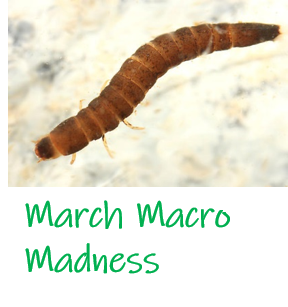
Like other insects, riffle beetles go through several life stages. In their larval stage, they are
in fairly clean streams and rivers with riffles (no surprise given their name).
Like other animals the riffle beetle larvae molts. It sheds its exoskeleton after a new exoskeleton develops underneath. An exoskeleton can’t stretch as the larvae grows, so when it outgrows an exoskeleton it sheds it. They’ll go through 6 to 8 molts.
Riffle beetle larvae are elongate. You can see the head and all 3 pairs of legs if you look down at them from above. Their antennae and mouthparts are shorter than the head. The larvae have very fine gills that coming out of the tip of the abdomen. These can be pulled in for protection, or pulled in and out to increase oxygen flow.
As larvae they appear to be collector-gatherers and scrapers. They eat algae and other plant material in the water that either grows there or falls in. The larvae are rarely eaten by other invertebrates, but fish do eat them.
Several sources explain the human caused threats to the riffle beetle larvae include lower oxygen concentrations in streams and rivers, increased water temperatures in streams and rivers (water temperatures can go up because the tress along a stream are removed for examples), big changes in the amount of water flowing in a stream, and pollution.
Mayfly nymphs (Epeorus)
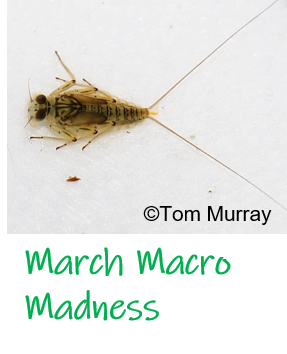
Adults mayflies are on the top 5 list of a trout’s favorite foods. The nymphs are found in fast flowing water on either soft or firm creeks bottoms.
They are scrapers or collector-gathers. They eat algae or decaying plant material.
Mayflies are sensitive to pollution. If they’re in a creek you’re probably going to have good water quality.
One reason they’re a good indicator is because they’re found in a lot of different habitats (soft stream bottoms, hard stream bottoms, in rocks, on plants, etc.). They are also easy to find and there are usually a lot of them.
Mayfly larvae are part of the widely used EPT Index (Ephemeroptera-Plectoptera-Trichoptera). This is a system used to measure water quality. Biologists count the number of different types of mayflies, stoneflies, and caddisflies and those numbers determine where on the scale the water quality falls.
Stonefly nymphs (Leuctra)
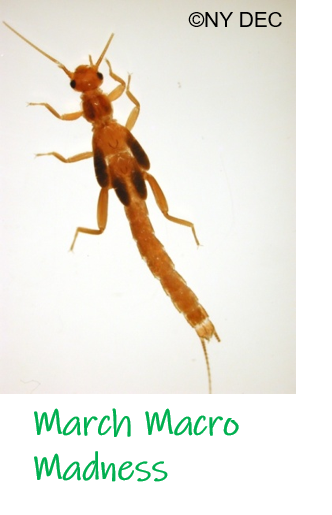
Stoneflies are found in most running waters. You can find them in boulder, cobble, water-soaked wood, and leaf packs.
Most species are predators or shredders. The shredders eat decaying plant material.
Stoneflies like clean, cool flowing streams. Most stonefly taxa are sensitive to water pollution.
Like mayflies, the presence of stoneflies is a reliable indicator of excellent water quality. If stoneflies aren’t in a stream, however it doesn’t necessarily mean the waterbody is polluted. Stoneflies have a very specific habitat conditions and it may just mean the habitat isn’t there.
Stonefly larvae are also part of the widely used EPT Index (Ephemeroptera-Plectoptera-Trichoptera) to measure water quality condition. This is a system used to measure water quality. Biologists count the number of different types of mayflies, stoneflies, and caddisflies and those numbers determine where on the scale the water quality falls.
A fun fact, in low oxygen conditions, larvae will do “push-ups” to move water across their gills.
Caddis fly larvae (Pycnopsyche)
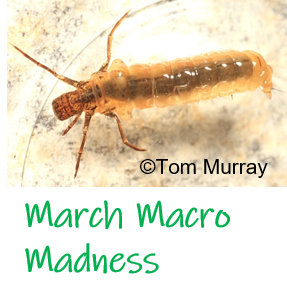
Female Caddisflies lay their fertilized eggs directly in water, or just above the water line on plants. When the eggs hatch a worm-like larvae emerges.
The larvae will live underwater for sometimes as long as a year. They use their feathery gills to breathe.
Caddisfly larvae build houses for themselves. They are general a “straw” shape with the larvae inside the hole. They will carey the house with them everywhere they go.
After pupating into their winged adult form, they crawl or float out of the water and fly away. Adults have short life spans (just a month or so).
